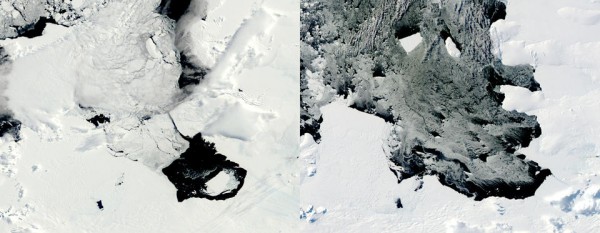
This
combination of Dec. 10, 2013, left, and March 11, 2014 photos provided
by NASA shows a large iceberg separating from the Pine Island Glacier
and traveling across Pine Island Bay in Antarctica.
One of the largest icebergs on the planet, about six times the size of
Manhattan, has separated from an Antarctic glacier and is floating out
towards open ocean. The iceberg is named B-31, and is roughly 255 square
miles (660 square km). Its estimated maximum thickness is 1,600 feet
(487 meters). Last Fall, it broke off from the Pine Island Glacier.
Researchers have been watching it drift away since then, via satellite.
"The ice island, named B31, will likely be swept up soon in the swift currents of the Southern Ocean, though it will be hard to track visually for the next six months as Antarctica heads into winter darkness," according to scientists at NASA's Earth Observatory monitoring its progress.
From Reuters:
NASA glaciologist Kelly Brunt said on Wednesday the iceberg covers about 255 square miles (660 square km) and is up to a third of a mile (500 meters) thick. Known as B31, the iceberg separated from Antarctica's Pine Island Glacier last November, Brunt added. "It's one that's large enough that it warrants monitoring," Brunt said in a telephone interview, noting that U.S. government organizations including the National Ice Center keep an eye on dozens of icebergs at any given time.The iceberg isn't in the way of shipping lanes at this time. One of the funny things about this news story is how each news organization selects a different geographical entity to compare the iceberg's size to. CNN, based in Atlanta, chose Atlanta; AP chose Guam (Really? Guam?), Reuters chose NYC.
NASA time-lapse video below.

No comments:
Post a Comment